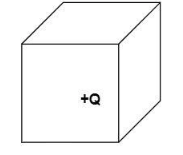
At the centre of a cubical box $ + Q$ charge is placed. The value of total flux that is coming out of each face is:
(A) $Q/{ \in _0}$
(B) $Q/3{ \in _0}$
(C) $Q/4{ \in _0}$
(D) $Q/6{ \in _0}$
Answer
561.3k+ views
Hint:Find whether the given surface is Gaussian surface or not. If it is a Gaussian surface apply the gauss formula and substitute the number of faces that it encloses to find the electric flux that comes out of each face of the given closed surface.
Useful formula:
The Gaussian law is given as
$f = \dfrac{Q}{{{ \in _0}}}$
Where $f$ is the total electric flux, $Q$ is the charge enclosed by the surface and ${ \in _0}$ is the permittivity of the free space.
Complete step by step solution:
It is given that the charge of $ + Q$ is placed at the centre of the box. The Gauss’s law provides the information about the distribution of the electric charges for the closed surface. In the closed surface, the electric flux is directly proportional to the electric charges enclosed in the surface.

In the given question, the cubical surface encloses the charge $ + Q$ . Since the cube is the closed surface with the six faces, the gauss law can be applied to find the electric flux of it.
By using the formula of the Gaussian law,
$f = \dfrac{Q}{{{ \in _0}}}$
Since the cube contains the six faces, the permittivity of the free space is multiplied by six to find the flux from each face.
$f = \dfrac{Q}{{6{ \in _0}}}$
Hence the electric flux that is coming out of each flux is obtained as $\dfrac{Q}{{6{ \in _0}}}$
Thus the option (D) is correct.
Note:The Gauss law is used for the determination of electric field over the closed surface and the charge distribution in it. Remember that if the charge $Q$ is placed outside of the cube, there will be no electric flux on the closed surface. Hence the charge on the surface alone can contribute to the electric flux.
Useful formula:
The Gaussian law is given as
$f = \dfrac{Q}{{{ \in _0}}}$
Where $f$ is the total electric flux, $Q$ is the charge enclosed by the surface and ${ \in _0}$ is the permittivity of the free space.
Complete step by step solution:
It is given that the charge of $ + Q$ is placed at the centre of the box. The Gauss’s law provides the information about the distribution of the electric charges for the closed surface. In the closed surface, the electric flux is directly proportional to the electric charges enclosed in the surface.

In the given question, the cubical surface encloses the charge $ + Q$ . Since the cube is the closed surface with the six faces, the gauss law can be applied to find the electric flux of it.
By using the formula of the Gaussian law,
$f = \dfrac{Q}{{{ \in _0}}}$
Since the cube contains the six faces, the permittivity of the free space is multiplied by six to find the flux from each face.
$f = \dfrac{Q}{{6{ \in _0}}}$
Hence the electric flux that is coming out of each flux is obtained as $\dfrac{Q}{{6{ \in _0}}}$
Thus the option (D) is correct.
Note:The Gauss law is used for the determination of electric field over the closed surface and the charge distribution in it. Remember that if the charge $Q$ is placed outside of the cube, there will be no electric flux on the closed surface. Hence the charge on the surface alone can contribute to the electric flux.
Recently Updated Pages
Master Class 12 Business Studies: Engaging Questions & Answers for Success

Master Class 12 Economics: Engaging Questions & Answers for Success

Master Class 12 English: Engaging Questions & Answers for Success

Master Class 12 Maths: Engaging Questions & Answers for Success

Master Class 12 Social Science: Engaging Questions & Answers for Success

Master Class 12 Chemistry: Engaging Questions & Answers for Success

Trending doubts
What are the major means of transport Explain each class 12 social science CBSE

Which are the Top 10 Largest Countries of the World?

Draw a labelled sketch of the human eye class 12 physics CBSE

Explain sex determination in humans with line diag class 12 biology CBSE

The pH of the pancreatic juice is A 64 B 86 C 120 D class 12 biology CBSE

Give 10 examples of unisexual and bisexual flowers




